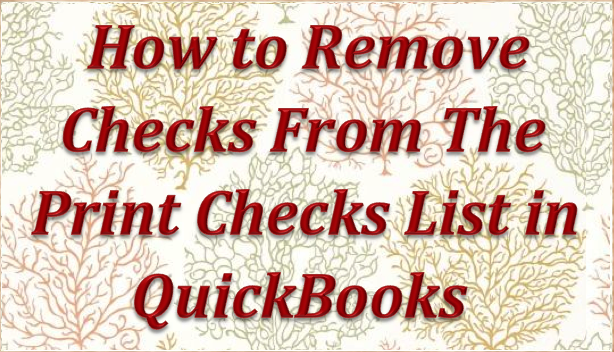by Marie | Oct 10, 2016 | QuickBooks for Mac, QuickBooks for Windows, QuickBooks Online, Troubleshooting

You probably had some checks that were marked “To Print” in the desktop edition, but were never printed. No worries though, this can be taken care of pretty simply by one of two methods.
- There is a handy tool in the new QuickBooks Online that lets you remove the checks from the list. Simply select all the checks you want to have removed from the list, and check the box at Remove from list
- The next method is to print to PDF which will get the checks out of the print list without wasting your ink or paper. After selecting “Print” choose Save as PDF at the bottom left of the Print screen. Name the file and choose a location to save it to. Click Save. (This method is the only one that can be used to clear checks in the desktop editions of QuickBooks.)
Either method can be used, and will not interfere with your data in any way, as printing checks has absolutely nothing to do with your direct financials.
How to Print Multiple Checks/Batch Print in QuickBooks
After you have recorded the bill payments in QuickBooks Online, they can be batched printed from the print checks page.
- Click the Plus sign at the top center of a main page
- Select Print Checks under Vendors
- Check the boxes to the left of the checks you wish to print and click Preview and Print on the bottom
- Click Print on the preview page to send the checks to the printer
by Marie | Oct 4, 2016 | Classes & Location, Company Setup & Management, Financial Statements & Reports, Preferences & Customization, QuickBooks for Mac, QuickBooks for Windows, QuickBooks Online

The main difference between class and account, is that every transaction must have an account assigned to it, while it’s optional to assign a class. So think of the class list as having a second chart of accounts which you can apply to transactions to group them into categories different from those provided by the Chart of Accounts.
Accounts mostly organize transactions into financial categories – income, expenses, receivables, payables etc., but classes let you organize transactions into any categories you want, and you have full control over what those categories are. The Class list is empty when you first create a QuickBooks company file, so you can set up any number of classes you want in it. Most often you’ll use classes for grouping transactions into management information categories as opposed to the financial accounting categories provided by the Chart of Accounts.
As a general rule, use accounts to identify the “what” of a transaction and classes to identify the “why” or “what for”. For example, if you buy Office Supplies for multiple departments and you want to keep track of each department’s use, the “what” is office supplies; the “what for” is the various departments – administrative, sales, production, etc. So office supplies (expense) should be an account and each department should be set up as a class.
Creating lots of sub-accounts is a common mistake among new QuickBooks users; however, it should be avoided at all cost. To illustrate the problem, consider this fragment from a simple chart of accounts:
Office Supplies
Marketing
Accounting
Now here is the same fragment of the chart of accounts, but with sub-accounts added:
Office Supplies
Administrative Department
Sales Department
Production Department
Marketing
Website
Events
Accounting
Bookkeeping
Audit Prep
As you can see in the illustration, the account list can become exponentially long which will produce very lengthy, unattractive financial reports. The Classes list in QuickBooks can have up to five levels (classes and subclasses), which gives you more functionality and flexibility in using the class feature. To have class information arranged in reports in a way that provides the most benefit, it does help to give some thought as to how the list should be structured.
To Turn on Class Tracking in QuickBooks Windows – Pro, Premier, Enterprise:
- Click on Edit, then Preferences in the main menu to open the Preferences window.
- Click on the Accounting icon in the left pane of the Preferences window.
- Select the Company Preferences tab in the right pane.
- Checkmark the Use class tracking item on the Company Preferences tab.
- Click OK to close the Preferences window.
To Turn on Class Tracking in QuickBooks Mac:
- Click on QuickBooks, then Preferences in the main menu to open the Preferences window.
- Click on the Transactions under Workflow and check the box that says Use class tracking.
- Click OK.
To Turn on Class Tracking in QuickBooks Online:
There are four (4) levels of Quickbooks Online subscription: 1) Simple Start, 2) Essential, 3) Online Plus, 4) Advanced. Class tracking is only available in the Online Plus and Advanced editions.
- Click on the Gear icon at top right of screen (your company name) and select Account and Settings under the Your Company tab
- Click the Advanced button in the left menu bar, then click the pencil icon at Categories to edit preference.
- Check the box at Track classes (You may also want to check the box at Warn me when a transaction isn’t assigned a class)
- Click Save.
After completing these steps, a Class column will appear in many of QuickBooks’ form windows. In some cases such as for invoices, you may have to customize the form’s template to have the Class column appear.
by Marie | Oct 4, 2016 | Adjustments & Corrections, Bookkeeping 101

It is never a good idea to make changes to past accounting periods that you have already filed tax returns for. However, if you must, you need to ensure that the changes you are about to make will not throw off the previous years balance making them out of synch with your latest tax return numbers. Thus if you are correcting it to make it synchronize with your tax return, then by all means you should go right ahead. It simply means your tax preparer made the corrections when filing the tax return but the correction just hasn’t been entered in QuickBooks as yet.
Also, bear in mind that depending on the type of journal entry you are correcting, and the accounts it affects, it may be worth making a new journal in the current year to offset that journal or the parts of it that needs correction.
The fact that you need to correct it means it is incorrect, but if the period is closed by someone else and password protected, making a new one in the current year may be the only option you have.
How to Correct an Error in Revenue or Expenses Made in the Last Tax Year, but Not Discovered Until Current Tax Year
At year-end, net income is closed out to Income Summary, which is then transferred to the owners’ equity account Retained Earnings (corporations) or Capital (partnerships, sole proprietorships). Thus, this account includes last year’s net revenues and expenses. To add back omitted revenues, you credit Retained Earnings or Capital and to add back expenses, you debit one of these accounts. Here are a few pointers with examples:
- To correct an expense omitted or understated in 2015 after the books are closed, debit Retained Earnings (or Capital) to reduce the balance.
- To correct an expense overstated in 2015 after the books are closed, credit Retained Earnings (or Capital) to increase the balance.
- To correct revenue omitted or understated in 2015 after the books are closed, credit Retained Earnings (or Capital) to increase the balance.
- To correct revenue overstated in 2015 after the books are closed, debit Retained Earnings (or Capital) to reduce the balance.
As usual, it’s always a good idea to consult with your tax preparer/CPA to ensure you are both on the same page with the books. Some changes made after a period’s tax return is filed, may need to be handled with the filing of an amended tax return.
by Marie | Oct 2, 2016 | Banking Setup & Management, Chart of Accounts Setup & Management, QuickBooks for Mac, QuickBooks for Windows, QuickBooks Online

First, I want to say that you need to be absolutely sure that both accounts are for the same bank account before making the merge. Once merged, it cannot be un-merged! Also, if you are using a desktop edition of QuickBooks, do make a backup before proceeding with this merger. It is good practice to make a backup copy before doing anything major in your QuickBooks company file.
How to Merge Two Bank Accounts in QuickBooks
First you’ll want to go to the Chart ofAccounts and select the bank account that you want to be gone. Next, edit this account and make the spelling of the name be the exact as the one you are keeping. (A pop up box will open with a message “This name is already being used. Would you like to merge them?”) Answer Yes then Merge Accounts if asked, and your bank accounts will be merged.
- Go to List and select Chart of Accounts
- Select the bank account you do not want to keep, and click Edit at bottom left.
- Type the name of the Account you are keeping, the exact way it is on the one you are keeping, and click Ok.
- You will now be asked to confirm if you really want to go ahead with the merge. Answer Yes then Merge Accounts if asked, and your accounts will be merged.
Note: This is the same method used to merge other chart of accounts, vendors, or customers.
by Marie | Oct 2, 2016 | Company Setup & Management, Financial Statements & Reports, QuickBooks for Mac, QuickBooks for Windows

I do not recommend deleting memorized reports in QuickBooks as it has been known to cause the file to be corrupted.
One alternative is to create a folder called something like “Inactive” or “Old” and move the unwanted memorized reports there instead. Of course, this does not always happen as I have had a lot of clients do this without a problem, but it has happened multiple times in the past and you don’t know when it will happen and you certainly do not want your files getting corrupted.
How to Delete a Memorized Report in QuickBooks Windows – Pro, Premier, Enterprise
- Go to Report, then select Memorized Report List
- Select the report you want to delete in order to highlight it, then click the Memorized Report dropdown at bottom left and select Delete Memorized Report.
- Click Ok.
How to Delete a Memorized Report in QuickBooks Mac
- Go to Report, then select Report Center and click Memorized Reports
- Select the report you want to delete in order to highlight it, then click the X to the left of it.
- Click Ok.







Recent Comments